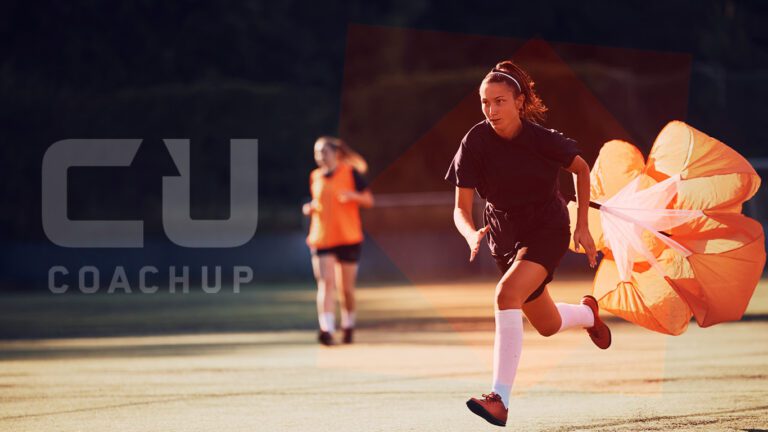Linear speed training is a hot topic in all sports. After all, no matter what sport you play, it’s beneficial to be fast. As simple of a movement as running is, there are many factors within it that must be taken into account. This is referred to as the kinematics of running.
These kinematics include measures of stride length, stride frequency, range of motion measurements at each joint, and ground contact time to name a few. To refrain from getting too scientific, I will give my thoughts on three types of resisted sprint drills in terms of their benefits and drawbacks for athletes using them.
There are three very popular types of resistance drills: Parachute sprints, sled sprints, and hill sprints. Studies have shown that all of these drills benefit athletes by increasing their acceleration rate, but from an application standpoint, how do these tools measure up? As a semi-professional track athlete for four years, and now a track coach for over 10, I have had the opportunity to use and coach all of these disciplines personally.
First, from a few research articles…
- [1] One study took experienced athletes and trained them 3 times per week for 4 weeks with a large parachute and spiked shoes doing 50 meter sprints. After 4 weeks, the resisted sprint group improved their 0-20 meter speed by 3.3% compared to the unresisted group who improved by 1.8%.
- [2] The next study compared inclined treadmill and ground resistance training (sled resisted). The inclined resisted group increased their speed from 0-9.1 meters by 5.4%, compared to the ground resisted group who increased their 0-9.1 meter velocity by 2.9%.
- [3] A study examined 8 weeks of 2x/week training of light sled (around 13% of body mass) towing versus heavy sled (around 43% of body mass) towing on 10 meter acceleration times. The heavier sled towing group significantly decreased their 5 meter acceleration by 5.7% and the 10 meter acceleration by 5%, whereas the lighter sled towing group only increased 5 meter acceleration by 2.8% and 10 meter acceleration by 3%.
Now for the application…
Parachute resisted training
Parachute resisted sprinting was one of the most popular forms of resisted sprint training in the early 2000s. This tool was very popular for two main reasons. First, the parachute’s aesthetic effect. There was nothing cooler than watching your favorite NFL player sprint down the field towing a giant parachute behind him then going to practice and doing the same thing yourself. The second big reason for their popularity was the accessibility. The equipment could be easily placed in a bag and carried anywhere you went. You could also pull them out and use them in any location where you had 40-70 meters to run. This seems like a perfect tool, right?
For all its positive traits, the parachute has a few glaring negatives as well.
The biggest issue with the parachutes is getting them to inflate completely. Too often, I’ve seen athletes take off into their acceleration to find that it took the parachute the first 10-20 meters to inflate. By that time, the athlete is out of their acceleration phase. This is very counter-productive considering the parachute has the greatest effect on the acceleration phase and not the top end speed portion of the sprint.
The second issue is the lack of ability to adjust the parachute for the athlete. If you have only one or two parachutes of the same size and you train athletes of different ages and strength levels, then you will inevitably have a younger athlete who struggles against the resistance of a parachute that is too large for them, causing the biomechanics to be altered in a negative way. On the flip side, you may have an older, stronger athlete dominating the parachute without a way to increase the resistance.
Sled resisted training
Sled resisted training implements are becoming more popular in all areas of athletics. If you follow any training facilities on Instagram, you will likely see a weighted sled used in a myriad of exercises with all levels of athletes. This tool, like the parachute, has a great amount of aesthetic and audible appeal to it for athletes. This is the image of an athlete overcoming the forces of a massive steel object at high power outputs to show his/her prowess over that piece of metal. With all the hype surrounding sled-resistance, is it the top tool for athlete development?
To be honest, the sled is one of my favorite training tools.
First, the sled is great for providing a constant backward force throughout the exercise unlike the parachute which can change magnitude based on wind speed and direction. The sled allows for the user to load it to the level that is sufficient for power development without detriment to kinematics. I will adjust my sled weight based on the athlete’s performance. If the athlete is fully recovered and prepared for training, I will likely load the sled heavier than normal to increase the training stimulus. However, if the athlete is tired, sore, had a long day in school, or is being impacted by an external stressor, then the load will be decreased. I have no mathematical formula; I simply use my eyes and observe. If I believe that the load is impacting the athlete’s mechanics in a negative manner, then the weight will be decreased. If I believe the athlete is excelling at the current weight and could handle more then I will increase the weight at that point. As you saw in the third cited study above, heavier sled sprints created a more positive outcome than lighter weights did. Ideally, I will keep the sled weight between 15% and 30% of the athlete’s body weight.
One other reason that I like the sled resisted sprint is the directional force of the pull by the sled.
When a parachute inflates, it typically rises over head which causes a backward and upward directional force. If this occurs within the acceleration, then it could pull the athlete out of his/her acceleration prematurely. Since the sled pulls backward and down, it does not have this upward pulling effect.
I can also adjust the point of force on the body by switching between a belt and a shoulder harness to attach the athlete to the sled. I commonly use a shoulder harness, for the reason that many athletes already have an issue achieving full extension at the hip when accelerating. By adding the weight belt you are introducing yet another force for them to overcome in order to achieve full extension.
The major drawback of the sled is accessibility. The biggest issue I have with the sled is its limitations regarding transportation. If you train in multiple locations as I do and you don’t have sleds and weights at each location, then you will be constantly loading and unloading multiple sleds and weights for each training session.
Hill sprints
The final tool that I see commonly used in acceleration training is incline training. I have experienced it both on hills and on high-speed treadmills.
The incline sprint drills are great drills for both increasing vertical force displacement and also improving mechanics. Nick Winkelman has done a great deal of research regarding external cues and their use within training. Last fall, I listened to him speak at the University of South Alabama regarding acceleration training and part of this talk incorporated external cueing. This technique refers to using the external factors of a training session to elicit results instead of the coaching providing all of the cues throughout the session.
One example that he used was inclined running. He explained that by having an athlete sprint uphill, they instinctually drop into a 45 degree angle, increase their hip and knee flexion, and gain full extension in the lower limb joints when applying force into the ground. When using an incline for training purposes, I try to place athletes on an incline anywhere from 5-30 degrees depending on the athlete’s level of strength.
The major drawback to hill training is quite apparent—finding the perfect hill. You must train when the weather is nice, and it must not be in use by other groups. Some groups have substituted a hill for high speed treadmills with the ability to reach excessive inclines. While I have used these in the past and understand their appeal, my greatest issue with these is the fact that the velocity is created by the treadmill. The athlete is not producing the force to make the treadmill run. In my opinion, this is an exercise in overspeed training in which the athlete is forced to keep up with the treadmill instead of determine their own velocity.
At the end of the day, if your biggest decision is to decide between the three of the tools above, then half the battle is already won. You have made a giant step in the right direction by just incorporating some type of resisted sprinting. Choose the option that is best for you based on the tools allotted to you and the time you have to spend in these areas.
As always, coach smarter, not harder.
- The Effects of Resistance Training Using Parachutes on Sprint Performance. KLIMENTINI MARTINOPOULOU, POLYXENI ARGEITAKI, GEORGIOS PARADISIS, CHRISTOS KATSIKAS, ATHANASIA SMIRNIOTOU. http://www.biologyofexercise.com/712.pdf
- Predictors of Sprint Start Speed: The Effects of Resistance Ground-Based vs. Inclined Treadmill Training. GREGORY D. MYER, KEVIN R FORD, JENSEN L BRENT, JON G DIVINE, TIMOTHY E HEWITT. http://www.accelerationqc.com/wp-content/uploads/ground-based-vs.-inclined-treadmill.pdf
- The Effects of Weighted Sled Towing With Heavy Versus Light Load on Sprint Acceleration. KAWAMORI N, NEWTON RU, HORI N, NASAKA K. Journal of Strength Conditioning Res.2014 Oct 28(10):2738-45. doi: 10.1519/JSC.0b013e3182915ed4.

With our 100% money-back guarantee and vetted coaches, anyone can achieve their full athletic potential. CoachUp is the safest and easiest way to find a coach for personalized training. Find your perfect coach today and become the athlete you want to be!
How useful was this post?
Click on a star to rate it!
Average rating 4.8 / 5. Vote count: 14
No votes so far! Be the first to rate this post.



